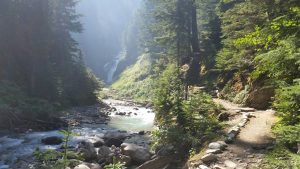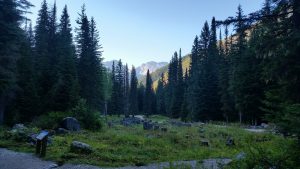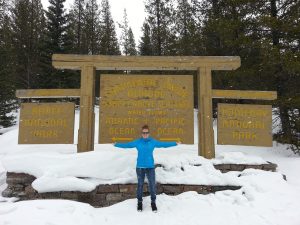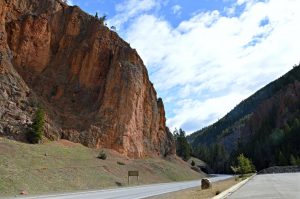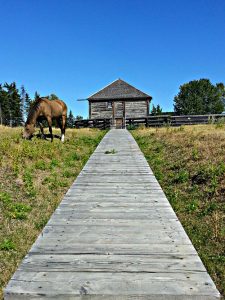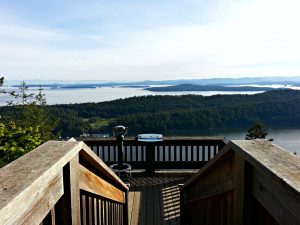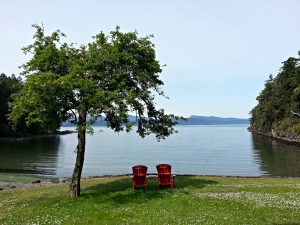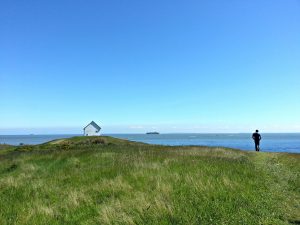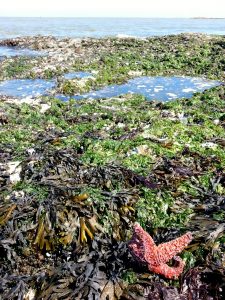Village of Radium Hot Springs, BC: A Great Place for a Fall Trip
With kids back to school, we decided to join the retirees and other seniors for some fall camping in the Kootenays. We started out from our home base in the Okanagan, headed south through Osoyoos to Rock Creek and stayed one night at Kettle River Provincial Park. We have camped there a lot but always in the heat of the summer, so it was nice to enjoy some cooler weather. From there, we headed east to Moyie Lake Provincial Park; located 20 Kilometres south of Cranbrook it had been years since we camped here and was nice to return. Both campsites had lots of space, and both were open until early October. Another welcome surprise was that since my husband had turned 65 this year and we were camping outside of the peak season; we were eligible for the seniors’ half price camping rate.

Radium was our next destination. We lived in Invermere when we were first married, and it is always nice to return to our old stomping grounds and see how things are changing. Radium still had the same welcoming feel, a mecca for outdoor enthusiasts young and old. Being that it was mid-September, we could sense that things were slowing down for the winter. We were immediately greeted by the bighorn sheep at the gas station as we pulled into town.

As far as RV accommodations go, we would recommend The Canyon RV Resort. We liked the flat treed sites with some right on Sinclair Creek, which can be viewed from the highway. From what I understand they close for the winter sometime in October, so check to make sure they are open if you are travelling later into the fall. We agreed with the great reviews we had read online and will definitely be back. For those travelling without an RV or planning to camp, there are also many cute motels as well as high-end hotels available in the village.

While in Radium we wanted to check out The Springs Course. It is one of two golf courses, the other called The Radium Course. The Springs is consistently rated as one of the best in BC. It is located between two high mountain ranges, the Purcells and the Rockies. Its panoramic views of the Columbia River kept us in awe as they did many years ago when golfing there.
Next on the list, hot springs!! Just east of the Village of Radium is the entrance to Kootenay National Park and Radium Hot Springs. The hot springs and surrounding lands have long been used by Indigenous peoples. Radium Hot Springs got its name when trace amounts of Radium were found in the water. Parks Canada has a good overview of its history on their website.

A soak in the hot springs was at the top of my list; needless to say, it was beautiful. Another benefit of travelling in the early fall was that there was plenty of room to park and not too many people in the pool. It really has not changed much over the years. We used to love going to the pools in the winter when it was snowing, a real perk of living in the area. Another favourite memory of living in the area was going to Fairmont Hot Springs which is just about 30 minutes south. We used to soak in the hot springs after a day of skiing at the mountain just above them.

I have also heard that the Sinclair Canyon Trail network has some good trails with views of the creek, educational signs and rest areas with benches. We didn’t get a chance to do any of those this trip but saw one of the trail-heads just above the hot springs. It was hard to pass this one up, but we need a reason to come back!
After leaving Radium we ventured further into Kootenay National Park along scenic Highway 93. Many of the campgrounds were closed at that time of the year; they seem to have different fall closing dates, so good to check before arriving. We went for a great walk in Marble Canyon which is about 90 kilometres from Radium. The trail is short (about a kilometre), with neat rock formations as it winds its way along Tokumm Creek through the narrow gorge and across many bridges.

I can’t really describe how awe-inspiring and beautiful the mountain scenery is in Kootenay National Park, but it is definitely a great place to explore at all times of the year, including the fall.
TIP: If you find this blog interesting why not subscribe to the enewsletter and never miss another story!
For places to camp in this area and elsewhere in British Columbia go to the Camping Map.
Share your BC travel and camping photos using hashtags #campinbc #explorebc.
Where to Go Camping and RVing in British Columbia
British Columbia offers breathtaking natural scenery, diverse wildlife, and numerous outdoor activities and cultural events including hiking, fishing, cycling, and attending farmers markets or museums.

For a first-time camper, it’s a chance to immerse yourself in nature, disconnect from technology, and experience the serenity of the wilderness but also enjoy some culture.
There are four types of camping experiences to choose from and they offer a mix of frontcountry and backcountry access. Frontcountry means an area within 1 km of a park road or a highway. Frontcountry campgrounds are accessible by vehicle, and they offer a range of amenities not available in more remote locations. Backcountry campgrounds are still mainly vehicle accessible (some are hike in only) but usually on gravel or forestry roads and are more remote with limited facilities.

Choosing the right campsite and doing the research, you must consider factors such as location, amenities, scenery, and activities available. The map located on campingrvbc.com allows users to search and locate over 1,700 campgrounds offering unique camping experiences. Here is an overview of the opportunities.
Private RV Parks
In British Columbia, you can enjoy a variety of amenities at more than 400 of BC’s private sector RV parks/campgrounds that are well-maintained, accessible, and enjoyable for all levels of campers.
British Columbia’s independently owned and operated campgrounds provide services and facilities to suit every lifestyle and budget. Whether you prefer a full-service site with electrical, water and sewer hook-up, a limited-service site with just electrical and/or water, or perhaps a basic site for your tent or tent-trailer, you will find lots to choose from throughout all regions of BC and within all the terrains that this stunning province has to offer. Camp by a lake, on a river, at the foot of a mountain, or under a canopy of tall trees in the forest, it’s all here in BC.

Glamping
Don’t have your own home away from home? That is not a problem, as quite a few campgrounds offer “Glamping” – the opportunity to drive up in your own vehicle and rent an RV, Yurt or Cabin, or as some call it, “Ready to Camp units.” Reservations are always recommended as this type of vacation is popular. Most private sector businesses offer online reservation capability and many allow bookings up to 12 months in advance.
Parks Canada (National Campgrounds)
Parks Canada is responsible for protecting nationally significant examples of Canada’s natural and cultural heritage. They operate seven national parks in British Columbia that offer camping, of which four have glamping oTENTiks.

A great option for beginners, frontcountry campgrounds may include:
- washrooms with showers
- kitchen shelters
- electrical
- water hookups
- Wi-Fi access zones
Check first.
Parks Canada operates a reservation service that opens early in the new year but also has a selection of first-come-first-served campsites. Reservations are recommended as the demand is high in peak periods. National parks include: Kootenay National Park, Pacific Rim National Park and Mount Revelstoke National Park.

BC Parks (Provincial Campgrounds)
If it’s more wilderness that you seek, then BC Parks, which has over 640 Provincial Parks with more than 10,000 Frontcountry campsites and approximately 2,000 walk-in or backcountry campsites, as well as 39 group campgrounds. (If you’re venturing into BC’s backcountry, ensure you camp safely and responsibly and refer to a backcountry guide for more information).
Rustic Recreational Sites
For a more rustic feel, then you will want to visit Recreational Sites & Trails BC (RSTBC) who provide public recreation opportunities through the development, maintenance and management of a network of recreation sites and trails throughout British Columbia. The BC Ministry of Tourism Culture and the Arts maintains more than 1,200 recreation campsites under this program.

Other Camping Opportunities
Campertunity is an online marketplace that showcases campsites for you to rent on private land throughout BC. There are also opportunities to rent trailers, domes, yurts, and cabins.
Know the Camper’s Code
All campground operators have rules and a behaviour etiquette, but the industry has endorsed the Camper’s Code as an approach to develop a friendly camping culture.

The camper’s code has 9 rules that are really easy to follow. When all campers follow them, camping is enjoyable for all, nature stays pristine, fellow campers become friends and animals stay wild and free. www.camperscode.com
Whatever you have for a first-time experience, take the time to sit and see the wildlife and listen to the sounds of camping, because “It’s always a great day to #CampinBC”.
TIP: If you find this blog interesting why not subscribe to the enewsletter and never miss another story!
To find camping accommodations throughout British Columbia go to https://www.campingrvbc.com/
Share your BC camping and travel photos at hashtag #campinbc
It’s always a great day to #campinbc
7 Steps to Getting Your Camper or RV ready for the Camping Season
Like others who Camp and RV, when we get a day or two of sunshine at this time of year, we start counting the days until the first trip. Now it’s time time to plan the days, the camping days that is. How many trips can be enjoyed in the Spring, Summer and if I am lucky (weather wise), right into the fall and beyond. First thing after the planning is the preparation of the home away from home for it’s first outdoor adventure of the year. We have a 24.5-foot Denali and here are the seven main steps I take to prepare.

1. Start Booking Your Camping Spots
It’s time to do the camping mambo, so to speak. We turn to our calendars, or in my case my cell phone’s digital one. I plan all my trips in that handy, trusty little box, that does such a good job that I have now enlisted it to telling me when to book. This year I want to camp in a BC Provincial Park, so I will go online to BC Parks reservation system to make a booking. They have information on their site about how far in advance you can book and which sites require a reservation. I check with friends to see who will join in, and then enter my data and book it as soon the reservation system allows me. If you prefer you can call the BC Parks call center, but remember there is an additional charge for this service and the wait times can be lengthy, my advice is to book online.
Reservations for 2024 are already open for Parks Canada sites, and private campgrounds are already booking up fast. Get more information on most campgrounds in BC here.

2. Air Out The Unit And Give It A Good Clean
So now I’ve booked my site, and it’s time to “wake up” my home away from home. It’s been a fairly mild fall and winter so it’s time to think about the unveiling of the RV, Motorhome or even the tent. Who says you can’t bring out the tent and dust it off, set it up and make sure that all the zippers, pulls and guy wires are intact? Great time to give it a wash and really air it out. Tenter’s often don’t give a thought to their sleeping accommodation until packing the vehicle for the trip or worse, they arrive at the location and find that its missing pieces or it has “had” a winter stow-a-way. Let this year be different – a prepared year.

It really doesn’t matter what your mode of camping is, they all have similarities that need attending to. Chances are your RV or camper has been closed up, unattended for the last five months. First thing to do is take off the protective covering you used for storing. But before pulling it off, why not give it a really good shampoo and a hose down and let it dry, before packing it away for the next five plus months. You will feel better about storing the cover clean, so when it comes time to put the RV to sleep for next winter it’s one less thing to do.

3. Time For Maintenance on Your Tires
We have finished washing and drying the cover which is stored for the season -– what’s next? Tires. The vehicle has been leaning on them for the winter and they might just be a little “tired”, so why not take the time now to inflate, rotate, clean and grease the bearings. Checking over every inch of the outside is the best place to start. Make sure there are no new problems that need attending to both on the outside you can see and the inside tire wall you cannot. We also apply tire protectant to the walls of the tire.
4. Water System On Board? Time For A Good Flushing
If you have a travel trailer, tent trailer, fifth wheel, motorhome or even a truck camper, chances are you have a water system attached that you winterized for the winter. You probably used a non-toxic antifreeze in the late fall designed for RVs and will now need to flush the system out with fresh water until there is no more pink water flowing. Once this is done, some people like to add a ¼ cup of liquid bleach and run it through the tank and then flush it once again with fresh water. Once this is done, it is now time to turn the heater’s bypass valve into the operating (normal) position and check each and every tap and faucet for leaks. Better to find it now rather than on a camping trip.

5. Check Your Batteries
Always wear protective safety gear when checking batteries at any time. First, make sure you have disconnected the hook-up power (the 120V power cord) and then make sure that all power is in the OFF position. We trickle charge our trailer all winter to maintain charge to the battery – other friends remove their batteries in the fall and keep them stored with a trickle charge in their shed or garage. Check the battery connections to make sure that they are clean and that the terminals have not corroded over the fall and winter. Check all sides including the bottom of the battery for cracks, as this sometimes happens during a severe winter freeze. Replace all cracked batteries. Check the battery fluid levels and only use “distilled water”.

6. Inspect Propane Tanks
Propane tanks are the next item up for inspection. Make sure the tanks are in the off position. This is where you want to check hoses, regulators and valves for premature aging and/or drying out. Check the date stamp is within ten years as they cannot be filled if older, unless they are re-valved. If you notice any of the above, replace and then proceed to testing the refrigerator, stove and furnace all work when the propane is engaged.
TIP: If you find this blog interesting why not subscribe to the enewsletter and never miss another story!
7. Clean the Inside
Final things to do, is give the whole inside a complete wash, vacuum and wipe out all cupboards and drawers. I always do a thorough clean before putting the RV to sleep for the winter but I also do a spring clean to freshen the trailer. It allows me to check for leaks, mold or if an unwanted pest has entered. I then open windows to air out the rig to make sure I have clean air for the first trip. As well as inside, I clean out the pass-throughs and repacking this allows me to confirm I have all items needed for the first camping trip and to purge unwanted items.
For more tips check out: RV Maintenance Tips for Keeping Your Exterior in Top Shape
To locate places to camp in BC go to the Camping Map.
Share your BC travel and camping pictures using hashtag #campinbc, #explorebc
It’s always a great day to #CampinBC
A Primer to Canada’s National Parks in British Columbia
National Parks are one of my favourite places to visit. In fact, after my husband and I got married in 2014, we packed almost everything we owned into a storage locker and set out on what turned out to be a 78-day camping trip across Canada focused primarily on visiting our National Parks and National Historic sites, guided by our National Geographic Guide to the National Parks of Canada.
Parks Canada has 148 National Parks, Historic Sites, and Marine Conservation Areas in the country. Of these 148 sites, nineteen are in British Columbia, which gives us plenty to explore!
Here are a few highlights to whet your appetite!

Hiking in Yoho National Park
- The 8.5 kilometre one-way trail in Yoho National Park to the Twin Falls Tea House National Historic Site is definitely worth your sweat! On the way back, take the alternate route passing by Marpole Lake for some spectacular views and to enjoy the black and orange streaked cliffs.
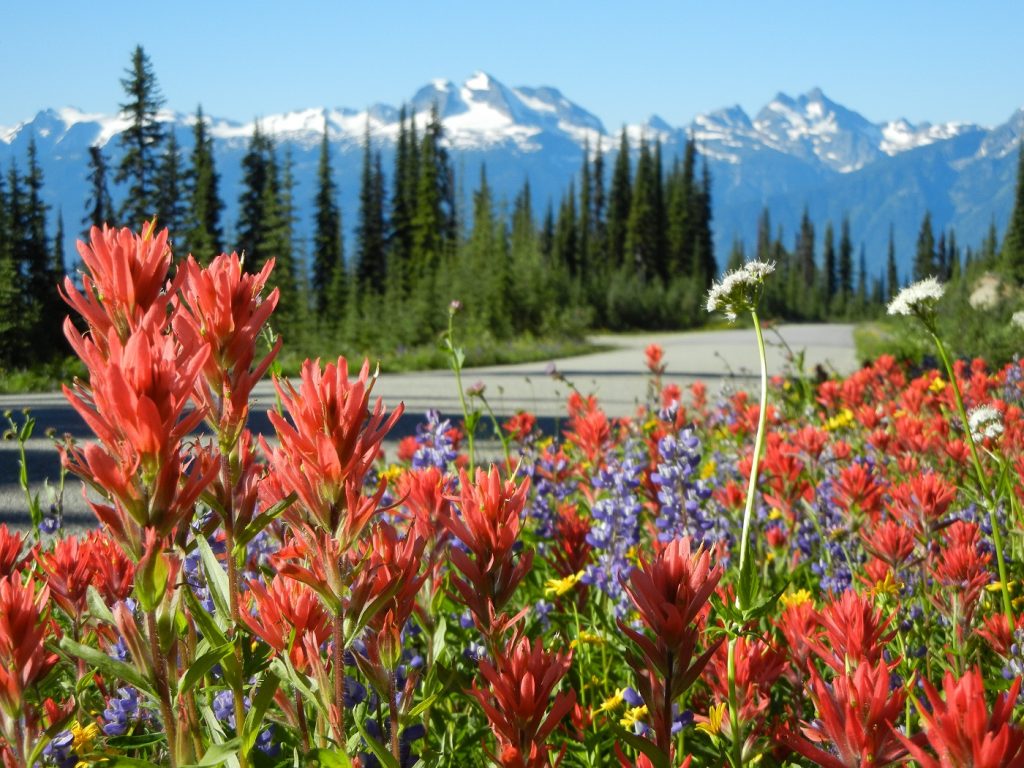
Meadows in the Sky Parkway, Mount Revelstoke National Park
- How often do you get to cover almost 2,000 metres of elevation in just 26-kilometres – and on a good paved road, nonetheless! Mount Revelstoke National Park provides that opportunity. For those feeing more adventurous however, leave the car at the bottom and hike the 10-kilometre Summit Trail to the top.

Kayaking the Broken Group Islands in Pacific Rim National Park Reserve
- For an adventure like none other, leave the city behind and head to Pacific Rim National Park Reserve’s Broken Group Islands. The Broken Group is made up of over one hundred islands of various sizes, some of which offer camping. If you are an experienced kayaker, you can head out on your own. If not, many tour operators can assist you with all stages of your trip. Make sure you give yourself at least three or four days to paddle to really experience the Broken Group.

Relaxing at Radium Hot Springs in Kootenay National Park
- For utter relaxation, head to Radium Hot Springs in Kootenay National Park and soak your troubles away. The odourless and clear naturally heated mineral pools are the biggest in Canada. The facility also offers a full-service day spa in case you are somehow still holding on to your worries after your soak in the hot springs.
Step back in History at Fort Langley National Historic Site
- Experience BC’s birthplace at Fort Langley National Historic Site. Try your hand at gold panning, watch the sparks fly in the blacksmith shop, and then stay overnight in the fort in an oTENTik

No matter which National Park or National Historic Site you choose, breathtaking scenery and fascinating history are waiting for you. Canada’s National Parks truly are some of the best places in the world, and living in British Columbia, we are so lucky to have many of them in our own backyard. The National Parks and National Historic Sites in British Columbia are:
- Yoho National Park
- Rogers Pass National Historic Site
- Mount Revelstoke National Park
- Glacier National Park
- Kootenay National Park
- Gulf of Georgia Cannery National Historic Site
- Fort Langley National Historic Site
- Gulf Islands National Park Reserve
- Fort Rodd Hill and Fisgard Lighthouse National Historic Sites
- Pacific Rim National Park Reserve
- Fort St. James National Historic Site
- Gwaii Haanas National Park Reserve and Haida Heritage Site
- Gwaii Haanas National Marine Conservation Area Reserve and Haida Heritage Site
- Chilkoot Trail National Historic Site
TIP: If you find this blog interesting why not subscribe to the enewsletter and never miss another story!
For more campgrounds in and around British Columbia check out the Camping Map at Camping & RVing BC.
Check out more blogs in the National Parks & Historic Sites series:
A Primer to Canada’s National Parks in BC.
BC’s Gulf Islands National Park Reserve Offers Rich Opportunities for Exploring
BC’s National Historic Sites Offer a Glimpse into the Past – Here are 3 to Explore
Kootenay National Park, BC Offers Great Vistas, Hiking & History
Visit Mount Revelstoke National Park in August for its Stunning Vistas & Wildflowers
Yoho National Park, BC – A Jewel in the Canadian Rockies
Glacier National Park: A Special BC Destination
Pacific Rim National Park Reserve – A Great Place to Visit in the Off Season
Share your BC camping and travel photos using hashtag #campinbc, #ExploreBC
It’s always a great day to #campinbc
Glacier National Park is a Spectacular BC Destination
If you type Glacier National Park into your web browser, many of the search results reference Montana’s large national park of the same name. If you dig a little deeper, you will uncover one of BC’s most spectacular and challenging destinations, which covers almost 1400km2 of BC’s Selkirk and Purcell Mountains.
Glacier National Park, in BC’s Kootenay region, is the first national park established in British Columbia and is one of the most interesting parks I have visited, as the spectacular views from the highway are juxtaposed with the challenges of accessibility.
For much of the year, Glacier National Park is blanketed in up to 14 metres (yes, metres!) of snow at the tree line, making the park inaccessible to all but the most experienced backcountry travellers.
While the Trans Canada Highway cuts directly through the park, Rogers Pass in winter can be a snow and ice hazard with 135 avalanche paths in a 40 km stretch affecting the highway.
By the time the snow melts away in the summer months, the Grizzly Bears have emerged from their winter slumber and many of the hiking trails in the park can experience restricted access, requiring groups of four people over the age of 12 to hike within three metres of each other.
Fortunately, Parks Canada has established numerous points of interest within the park that don’t require quite as much dedication to be backcountry prepared and make the park a perfect place to stretch your legs, camp for a few days, and experience some of what the park has to offer.
What to Do
Highlights in Glacier National Park include:
- Bear Creek Falls: A short but steep downhill walk brings you from the highway down to a spectacular waterfall. In the summer, enjoy the cooler temperatures the gorge offers by packing a picnic to enjoy along the creek.
- Glacier House: A luxury destination in the mountains from the early 1900s, the Glacier House hotel was established by the Canadian Pacific Railway. When the railway was re-routed through the 9 kilometre long Connaught Tunnel in 1917, visitors to Glacier House dramatically decreased and the resort was closed and eventually dismantled. Today, you can explore the ruins of the resort near the Illecillewaet Campground.
- Rogers Pass Discovery Centre: A National Historic Site in its own right, the Rogers Pass Discovery Centre is the only part of Glacier National Park that is accessible year-round. An excellent interpretive centre tells the history of the area and the nearby Rogers Pass Summit site offers spectacular views and informative outdoor displays. Note the Centre will be shut down as of May 2025.
- Rock Garden: This walk only takes about 20 minutes, but take your time and explore the moss and lichen covered boulders deposited during the last ice age. The trail consists of a jaunt through the forest, numerous rock staircases, and a trail through large boulders, so bring appropriate footwear.
- Loop Brook: Loop Brook is one of my favourite destinations in Glacier National Park. The trail starts at the Loop Brook Campground and travels just over a kilometre and a half through the forest along sections of the old railway grade. The highlights of the hike are definitely the enormous stone pillars that once carried the railway in a loop through the valley in order to reduce the grade of the railway. Excellent interpretive signage along the trail adds to the experience.
- High-Elevation Hiking: Undeniably, one of the best ways to experience Glacier National Park is to take a hike in the high country. There are numerous trails in the park and the information desk at the Illecillewaet Campground – where many of the most popular hikes depart – has a sign-up sheet for those people wanting to join up with others to form groups of 4.
In the Area
While in the area, consider visiting Mount Revelstoke National Park and Yoho National Park. Take a day trip to Golden or Revelstoke to experience life in a mountain town. Both offer many opportunities for eating, drinking, and recreation. Plan for a meal at the Wolf’s Den in Golden for one of the best burgers you will ever eat. In Revelstoke, stop by the Monashee Spirits Distillery to sample locally made liqueurs.
Where to Stay
Glacier National Park offers two campgrounds: Illecillewaet and Loop Brook. Both campgrounds are first come first served and offer a place to stay right in the heart of the park.
Glacier National Park is a dream destination for many backcountry and mountaineering enthusiasts, but it also has much to offer the casual visitor. There is a huge variety of hiking trails, from casual walks to demanding backcountry excursions. I have been to the park several times, but I feel like I have barely scratched the surface of what Glacier National Park has to offer and it is one of those destinations that keeps calling me back over and over again.
For more campgrounds in and around British Columbia check out the Camping Map at Camping & RVing BC.
Check out more blogs in the National Parks & Historic Sites series:
A Primer to Canada’s National Parks in BC.
BC’s Gulf Islands National Park Reserve Offers Rich Opportunities for Exploring
BC’s National Historic Sites Offer a Glimpse into the Past – Here are 3 to Explore
Kootenay National Park, BC Offers Great Vistas, Hiking & History
Visit Mount Revelstoke National Park in August for its Stunning Vistas & Wildflowers
Yoho National Park, BC – A Jewel in the Canadian Rockies
Glacier National Park: A Special BC Destination
Pacific Rim National Park Reserve – A Great Place to Visit in the Off Season
Share your BC camping and travel photos using hashtag #campinbc
Pacific Rim National Park Reserve, BC is a Great Place to Visit in the Off-Season
One of the best parts of living in British Columbia is being close to both the mountains and the sea. BC has a lot of mountain-based national parks, but it also is blessed with a spectacular coastline – and none more spectacular than what you find in Pacific Rim National Park Reserve on Vancouver Island.

Pacific Rim National Park Reserve is made up of three units spread along the west coast of Vancouver Island. Long Beach, the unit furthest north is the most accessible and arguably the best known. It is named after the 16-kilometre long stretch of sand lining Wickaninnish Bay and offers abundant opportunities for beach-combing, storm-watching, and surfing. Further south, the Broken Group Islands section is made up of over 100 small islands and is a dream destination for beginner and advanced kayakers alike. Further south still, the West Coast Trail is a challenging 75-kilometre backpacking route not to be taken lightly.

Pacific Rim National Park Reserve is a popular summertime destination, but it should not be overlooked for an “off-season” getaway. In the winter, the Pacific Ocean is whipped in to a frenzy and the storm watching is second to none. No matter which season you plan your visit, you will find many things to see and do while you are there.
What to do
Highlights in Pacific Rim National Park Reserve include:
- Beachcombing: One of the best things to do in Pacific Rim National Park Reserve is beachcombing. Pack a picnic lunch and spend the day wandering the shores of Long Beach. Bring your dog, too. Long Beach is one of the only dog-friendly protected areas in Canada, however dogs must be on-leash at all times.
- Kayaking: With some advanced planning, kayaking the Broken Group is an adventure you will never forget. The Broken Group is rich in wildlife, including sea lions, whales, and bears. It is also home to unique coastal features including sea arches and sea caves.

- Kwisitis Visitor Centre: Pacific Rim National Park Reserve is on the traditional lands of the Nuu-chah-nulth people. At the Kwisitis Visitor Centre you can take in the spectacular views from the deck before heading inside to learn about the area through a variety of exhibits. After your time at the Visitor Centre, head out for a self-guided walk on the Nuu-chah-nulth Trail.
- Surfing: Numerous licensed operators work in Pacific Rim and without too much trouble you should be able to find someone who can hook you up with rentals and lessons. Don’t forget a wetsuit, the water is cold even on the warmest summer day.
- Storm Watching: Pacific Rim National Park Reserve is not only a summertime destination. In fact, from November to March the park comes into its own as a winter storm watching destination and is known worldwide for its huge waves.

In the Area
Tofino and Ucluelet have capitalized on their coastal location and proximity to Pacific Rim National Park and both offer a variety of activities and attractions. In Ucluelet, check out the Wild Pacific Trail for an easy coastal walk. My favourite section of the trail is the 2.5 kilometre Lighthouse Loop that takes you out to the 102-year old Amphitrite Lighthouse. In Tofino, consider joining a tour or hiring a charter and heading to Hot Springs Cove, a series of natural hot pools accessible only by boat or float plane.

Where to Stay
Camping in Pacific Rim National Park Reserve can be a bit tricky as there is only one campground within the Long Beach unit. The Green Point Campground offers 94 drive-in sites and an additional 20 walk-in sites. During the summer season, advanced reservations are a must if you want to stay in the park itself. A handful of private campgrounds are available in both Tofino and Ucluelet, but just like in the National Park, make a reservation ahead of time if you are travelling during the busy summer season.
Pacific Rim National Park Reserve offers a huge range of opportunities for exploration. From highly accessible and popular options in the Long Beach Unit to the extreme backcountry of the West Coast Trail, you are guaranteed to find something to suit whatever your heart desires. Keep in mind this park’s popularity when planning your trip. It can sometimes be a challenge to find accommodation on busy summer weekends and you will be greatly rewarded if you book your trip in advance. Don’t worry, though, with 16 kilometres of sandy beaches in the Long Beach Unit, you are sure to find a place that feels as though it is meant just for you.
If this area interests you, check out our drive:
From Coast to Coast on Vancouver Island: Vancouver to Tofino
TIP: If you find this blog interesting why not subscribe to the enewsletter and never miss another story!
For more campgrounds in and around British Columbia check out the Camping Map at Camping & RVing BC.
Check out more blogs in the National Parks & Historic Sites series:
A Primer to Canada’s National Parks in BC.
Explore Fort Langley & Gulf of Georgia Cannery Historic Sites and Check Out Some of BC’s Fascinating History
BC’s Gulf Islands National Park Reserve Offers Rich Opportunities for Exploring
BC’s National Historic Sites Offer a Glimpse into the Past – Here are 3 to Explore
Kootenay National Park, BC Offers Great Vistas, Hiking & History
Visit Mount Revelstoke National Park in August for its Stunning Vistas & Wildflowers
Yoho National Park, BC – A Jewel in the Canadian Rockies
Glacier National Park: A Special BC Destination
Pacific Rim National Park Reserve – A Great Place to Visit in the Off Season
Share your BC camping and travel photos using hashtag #campinbc #explorebc
There’s always somewhere to #CampinBC
Kootenay National Park, British Columbia Offers Great Vistas, Hiking & History
Kootenay National Park, an often-overlooked neighbour to Alberta’s more popular Rocky Mountain Parks of Banff and Jasper, makes the perfect daytrip when exploring the region. It also offers enough to keep you busy for a weekend all on its own if you like stunning vistas, great hiking, and interesting history.
An added bonus to Kootenay National Park is that, unlike it’s BC neighbour, Glacier National Park, it offers things to see and do year-round. We visited Kootenay National Park at Easter during a particularly snowy year and still found ample things to do and see – just make sure you pack appropriately for the weather and check in at the Parks Canada visitor centre in Radium Hot Springs to make sure you don’t accidentally tread into avalanche territory if you are planning a winter visit.
What to Do
Kootenay National Park is a relatively narrow corridor stretching from Radium Hot Springs in BC to near Banff in Alberta. Established in 1920, the park provides road access to the Rocky Mountains from the Kootenays and protects a wide variety of environments including steep canyons, grassy meadows, steamy hot springs, roaring rivers, and fascinating ochre beds.
One of the best ways to explore Kootenay National Park is to use the Parks Canada Explora Kootenay App to take a GPS-guided driving tour of the 94-kilometre Banff-Windermere highway. Simply download the app, select if your travels are starting at the Radium Hot Springs end or the Banff end, and use Bluetooth to connect the app to your car stereo system. As you drive, the app will detect your location and provide you with suggestions for stopping points, interesting interviews with Parks staff about flora, fauna, and history, and the perfect amount of silence to help you simply enjoy the views.
When we visited, we actually did the driving tour twice – once listening to the app’s stories, history, and information while making only short stops, and once to visit the locations that required more time. At the Radium Hot Springs end of the road, there are a lot of stops close together and I found it a bit overwhelming at first, so doing it twice really helped to cut down on the feeling of having to do everything in a rush.
Here are a few highlights of what you can see and do in Kootenay National Park:
- Sinclair Canyon: As you enter Kootenay Park from the Radium end you will be immediately impressed as you drive through Sinclair Canyon. Park just past the canyon and walk back through it – you will feel tiny as the walls tower above you.
- Radium Hot Springs Pools: Bring your bathing suit and soak your cares away in the hot pool or get your exercise swimming laps in the cool pool.
- Kootenay Valley Viewpoint: Make sure you stop for a photo at this stunning location overlooking the Kootenay River.
- Dog Lake Trail: A less busy but completely worthwhile walk crossing the Kootenay River via suspension bridge and carrying on to Dog Lake. If you are short on time, turn around at the second bridge.
- Paint Pots: Take a walk back in history to orange ochre beds used by local First Nations and later European miners. Keep your eyes out for the mining equipment left behind.
- Marble Canyon: One of the most popular sites in Kootenay Park is this deep and narrow gorge where you can cross and re-cross the canyon on walking bridges.
- Continental Divide: Stand with one foot in BC and one in Alberta – and perhaps more interestingly, stand with one foot where all water runs to the Pacific Ocean and one foot where all water runs to the Atlantic Ocean.
In the Area
One of the benefits of visiting Kootenay National Park is the close proximity to so many other things to see and do. In the area, plan a visit to Invermere for the perfect afternoon treat at Gerry’s Gelato followed up by sampling a flight at the very funky Arrowhead Brewing.
Continue south and take a hike in the Hoodoos Trail near Fairmont Hot Springs for spectacular views – just stay away from the edge! If you still have time, carry on to visit Fort Steele Heritage Town near Cranbrook. On your way back, stop by Lussiar Hot Springs – a natural spring that bubbles out near the edge of the Lussiar River in Whiteswan Lake Provincial Park.
Where to Stay
Kootenay National Park offers a number of frontcountry and backcountry camping options. The Redstreak Campground near Radium is the largest and accepts reservations, but first-come first-served camping is also available at Marble Canyon and McLead Meadows during the summer months. For backcountry excursions, plan a multi-day hike along the 55-kilometre Rockwall Trail – just make sure to make your reservations in advance for this classic Rocky Mountain trek.
Kootenay National Park provides an excellent reprieve from the hustle and bustle common in Banff and Jasper without losing anything in terms of scenery or things to do. It is definitely one of my favourite parks to visit in the Canadian Rockies.
TIP: If you find this blog interesting why not subscribe to the enewsletter and never miss another story!
For campgrounds in and around British Columbia check out the Camping Map at Camping & RVing BC.
Check out more blogs in the National Parks & Historic Sites series:
A Primer to Canada’s National Parks in BC.
Explore Fort Langley & Gulf of Georgia Cannery Historic Sites and Check Out Some of BC’s Fascinating History
BC’s Gulf Islands National Park Reserve Offers Rich Opportunities for Exploring
BC’s National Historic Sites Offer a Glimpse into the Past – Here are 3 to Explore
Kootenay National Park, BC Offers Great Vistas, Hiking & History
Visit Mount Revelstoke National Park in August for its Stunning Vistas & Wildflowers
Yoho National Park, BC – A Jewel in the Canadian Rockies
Glacier National Park: A Special BC Destination
Pacific Rim National Park Reserve – A Great Place to Visit in the Off Season
Share your BC camping and travel photos using hashtag #campinbc #explorebc
It’s always a great day to #campinbc
BC’s National Historic Sites Offer a Glimpse into the Past: Here are 3 to Explore
British Columbia has a rich and fascinating history and Parks Canada National Historic Sites highlight pieces of this history. BC’s National Historic Sites are spread throughout the province, from East to West and from North to South. Several of the sites are within an easy day trip of the Fraser Valley. Others will require more planning and commitment. All are worth visiting.
Previously, we published a blog that highlighted two National Historic Sites that are easy day trips from Metro Vancouver. Today, we are talking about three National Historic Sites, Ford Rodd Hill and Fisgard Lighthouse, Rogers Pass, and Fort St. James, that are spread throughout the province and would make a great part of any summer vacation.
A common thread through many of Canada’s National Historic Sites is the Xplorers Program for the young and young at heart. This program includes a booklet highlighting activities at each site. As children complete the activities, they work their way toward earning a certificate and souvenir. The program is a great way to keep kids engaged and learning, and offers a lot of fun opportunities.
Fort Rodd Hill and Fisgard Lighthouse National Historic Sites
As the lone National Historic Site on Vancouver Island, Fort Rodd Hill and Fisgard Lighthouse does not disappoint. Fort Rodd Hill is an artillery fort complete with underground bunkers, guardhouses, and gun batteries. Fisgard Lighthouse makes history as the first permanent lighthouse on the west coast of Canada.
Fort Rodd Hill and Fisgard Lighthouse offer a variety of activities to keep the whole family entertained – from wildlife and bird watching to camping in one of Parks Canada’s oTENTik tents. There are also special events happening all summer, including a two-day event all about women on the home front and Victoria’s largest squirt gun battle!
Victoria has tons of other things to see while you are in the area. Consider stopping for a delicious fish and chips lunch at Red Fish Blue Fish in the Inner Harbour or taking a tour of the BC Parliament Buildings. If you head further west, stop for a walk at Witty’s Lagoon in Metchosin or a swim at the Sooke Potholes.
Rogers Pass National Historic Site
Rogers Pass National Historic Site can be found within Glacier National Park, making it the perfect weekend getaway. The Rogers Pass Discovery Centre is a replica railway showshed that tells the history of the immense difficulties in navigating Rogers Pass. This is the centrepiece of the National Historic Site, and the only portion of Glacier National Park that is open year-round.
Rogers Pass is crucial in Canadian history. It was through this area that the Canadian Pacific Railway linked British Columbia with the rest of Canada, bringing Sir John A. Macdonald’s promise of a railway from coast to coast to fruition. Running a railway through such rugged terrain was extremely difficult – especially due to the enormous amounts of snow Rogers Pass receives each year and the extreme avalanche danger. After only 30 years of operation, the Canadian Pacific Railway abandoned the Rogers Pass route and opted to build a 9-kilometre long tunnel through Mount Macdonald, alleviating some of the dangers associated with the railway. Today you can step back in time at the Rogers Pass Discovery Centre and see just how difficult early navigation was in British Columbia.
Plan your visit for the summer to make the most of Glacier National Park. In the winter, the park is inaccessible to all but the most experienced backcountry travellers. In the summer, however, Glacier National Park offers excellent hiking. Check out the Loop Brook trail for an easy walk along the old railway route. The trail passes by huge stone pillars that in a previous life suspended the railway above the valley floor.
Fort St. James National Historic Site
For a more northern experience, Fort St. James National Historic Site takes you back to the fur trade days of 1896. Each of the fort’s restored wooden buildings houses a unique display. At the Fur Warehouse, you can see and feel the pelts that made the fur trade profitable. At the Trade Store, you can trade one of your pelts in for the goods you need to survive. Personally, my favourite experience was the Officers’ House, where you can pop into the yard to take part in the Chicken Races!
One of the experiences unique to Fort St. James is the ability to stay overnight in the fort. Spending the night at the Murray House gives you the opportunity to live like it was 1896. From dinner at the Old Fort Café to a moonlight exploration of the fort, spending the night in this restored heritage building is an experience like none other.
In the area, consider stretching both your lungs and your legs on the Mt. Pope hiking trail located within the Mount Pope Provincial Park to get unbeatable views of Stuart Lake. When you get back, stop for a well-deserved ice cream cone at Little Jimmy Fry’s.
BC has some of the best National Historic Sites in the country. Our diversity of mountain and ocean sites guarantees that you will find something to suit your interests – all while learning about BC’s fascinating history.
[subscribe}
For campgrounds in and around British Columbia check out the Camping Map at Camping & RVing BC.
Check out more blogs in the National Parks & Historic Sites series:
A Primer to Canada’s National Parks in BC.
Explore Fort Langley & Gulf of Georgia Cannery Historic Sites and Check Out Some of BC’s Fascinating History
BC’s Gulf Islands National Park Reserve Offers Rich Opportunities for Exploring
BC’s National Historic Sites Offer a Glimpse into the Past – Here are 3 to Explore
Kootenay National Park, BC Offers Great Vistas, Hiking & History
Visit Mount Revelstoke National Park in August for its Stunning Vistas & Wildflowers
Yoho National Park, BC – A Jewel in the Canadian Rockies
Glacier National Park: A Special BC Destination
Pacific Rim National Park Reserve – A Great Place to Visit in the Off Season
Share your BC camping and travel photos using hashtag #campinbc #explorebc
It’s always a great day to #CampinBC
BC’s Gulf Islands National Park Reserve Offers Rich Opportunities for Exploring
The Gulf Islands are one of those places I forget how much I love until I revisit them. Recently my husband and I packed up our truck and camping gear, loaded our motorcycle into the back, and set out to explore Gulf Islands National Park Reserve on Pender and Saturna Islands.
Gulf Islands National Park Reserve was established in 2003 and stretches over 15 islands in the Salish Sea. Pender Island and Saturna Island have the largest park areas accessible by BC Ferries. Many of the other parts of the park are accessible only by kayak, sailboat, or powerboat.
No matter which island(s) you choose to visit, Gulf Islands National Park Reserve offers a wide variety of hiking, wildlife viewing, cycling, and watersport opportunities. The Gulf Islands are a place where time slows down, so make sure you plan lots of time for simply sitting by the ocean and relaxing.
What to Do
Gulf Islands National Park Reserve requires some extra planning to visit as destinations and park sites are scattered across many islands. Pender Island (actually two islands separated by a shipping canal dredged in the early 1900s) makes a great home base as it is (relatively) easily accessible via BC Ferries, offers several National Park sites on the island itself, and provides a great jumping-off point to visit other islands. On Pender Island, make sure you visit:
- Roesland: A former holiday resort, Roesland today houses the Pender Islands Museum and serves as the operational headquarters for Gulf Islands National Park Reserve on Pender Island. The property is a step back in time as you wander through the apple orchard, past the former seaside cottages, and out to the end of Roe Islet.
- Mount Norman: Get your heart pumping with a short but steep 1.5 kilometre hike to the highest point on the Pender Islands. With spectacular views westward towards Victoria, Mount Norman is an excellent place to be as the sun dips low in the sky.
- Roe Lake: For an easier stroll, take the moderate 1.5 kilometre loop around Roe Lake to visit one of the only freshwater lakes in the Gulf Islands.
- Oak Bluffs: Another excellent place to take in the sunset, Oak Bluffs is another short but hilly walk with great views. From this location, make sure you keep your eyes peeled for passing Orca whales. Please note the bluffs are not located in the national park reserve.
Saturna Island has the largest “chunk” of Gulf Islands National Park Reserve all in one area. The vast majority of Saturna’s interior is protected area, and as such, it is an ideal destination for an off-the-beaten-path experience. On Saturna, take time to visit:
- Mount Warburton Pike: As the highest spot on Saturna, and in all of Gulf Islands National Park Reserve, Mount Warburton Pike offers commanding views over the Salish Sea and the surrounding islands. Take an old logging road to the top for great views, and then carry on along the ridge of the island by foot.
- East Point: Home to a lighthouse since the late 1800s, East Point marks the transition between Boundary Pass and the Strait of Georgia. Pack a picnic and spend the day exploring sandstone cliffs and grassy meadows, and watch wildlife pass by right in front of you. East Point is home to the Saturna Island Marine Research and Education Society (SIMRES), so you are in the right place to spot Orca whales, sea lions, seals, and a variety of sea birds.
- Winter Cove: Take a 1.5 kilometer guided walk at Winter Cove to explore the many types of vegetation found on the Gulf Islands. Take your time, and enjoy beautiful views of the Strait of Georgia along the way.
In the Area
On Pender Island, Brooks Point Regional Park is worth the trip all the way to the Southeastern tip of the island. The park offers grassy meadows and rocky shores, and the perfect place to enjoy a picnic lunch. Pender Island also offers a variety of excellent places to eat and drink. Pick up beach snacks and a coffee or two at the Vanilla Leaf Bakery Café, sample local and amazing cider at the brand new Twin Island Cidery, and enjoy a glass of wine on the patio and a meal at the food truck at Sea Star Vineyards. Check in at the Pender Islands Community Hall to see what events and activities are on the menu for a truly local experience.
On Saturna Island, plan your visit to take in the Saturna Saturday Market where almost the whole island (all 350 residents!) shows up to buy local produce, preserves, locally made crafts, and artwork. Check the schedule ahead of time to see if you can time your trip to attend one of the excellent and informative SIMRES SeaTalks. We were lucky enough to catch a double feature about the Southern Resident Killer Whales and the Transient Orca Whales when we visited.
Where to Stay
On Pender Island, Gulf Islands National Park Reserve offers up three camping locations. There is a drive-in site at Prior Centennial, a walk-in site at Shingle Bay, and a boat-in site at Bedwell Harbour’s Beaumont Marine Park. All three sites are quite small, and reservations are highly recommended to guarantee your spot. On Saturna Island, hike or boat access camping is available and can be reserved at Narvaez Bay. Reservations are strongly recommended.
Gulf Islands National Park Reserve offers rich opportunities for exploration. You can easily fill a long weekend exploring the islands accessible by BC Ferries, but if you want to go further afield and into the boat accessible only areas, you will certainly need more time. Visiting the Gulf Islands is the perfect break from the rush of everyday life as it truly allows you to reset yourself to “island time” and get in touch with the beauty that surrounds you at Gulf Islands National Park Reserve.
TIP: If you find this blog interesting why not subscribe to the enewsletter and never miss another story!
For more campgrounds in and around British Columbia check out the Camping Map at Camping & RVing BC.
Check out more blogs in the National Parks & Historic Sites series:
A Primer to Canada’s National Parks in BC.
Explore Fort Langley & Gulf of Georgia Cannery Historic Sites and Check Out Some of BC’s Fascinating History
BC’s Gulf Islands National Park Reserve Offers Rich Opportunities for Exploring
BC’s National Historic Sites Offer a Glimpse into the Past – Here are 3 to Explore
Kootenay National Park, BC Offers Great Vistas, Hiking & History
Visit Mount Revelstoke National Park in August for its Stunning Vistas & Wildflowers
Yoho National Park, BC – A Jewel in the Canadian Rockies
Glacier National Park: A Special BC Destination
Pacific Rim National Park Reserve – A Great Place to Visit in the Off Season
Share your BC camping and travel photos using hashtag #campinbc #explorebc
It’s always a great day to #CampinBC
Explore Fort Langley & Gulf of Georgia Cannery Historic Sites & Check Out Some of BC’s Fascinating History
British Columbia has a rich and fascinating history and Parks Canada National Historic Sites highlight pieces of this history. BC’s National Historic Sites are spread out through the province, from East to West and from North to South. Several of the sites are within an easy day trip of Vancouver and the Fraser Valley. Others will require more planning and commitment. All are worth visiting.
This blog highlights two National Historic Sites, Fort Langley and Gulf of Georgia Cannery. Both are easily accessible day trips from Metro Vancouver, and in future blogs we will be talking about three National Historic Sites that are spread throughout the province and would make a great part of any summer vacation.
A common thread through many of Canada’s National Historic Sites (and Parks) is the Xplorers Program for the young and young at heart. This program includes a booklet highlighting activities at each site. As children complete the activities, they work their way toward earning a certificate and souvenir. The program is a great way to keep kids engaged and learning, and offers a lot of fun opportunities.
Fort Langley National Historic Site
Growing up in Hope, Fort Langley National Historic Site is the one I have been to the most often. A popular location for school field trips, Sunday strolls, and taking out of town visitors, Fort Langley continues to expand its offerings to ensure that there is something new to experience every time you visit. Recently, Fort Langley became one of 20 participating locations in the new Club Parka Program – a learning opportunity complete with singing, dancing, and activity pages. There is also a fun photo scavenger hunt you can complete while visiting the fort.
Fort Langley is a great place to explore. There are replica and original buildings, costumed interpreters, and live demonstrations throughout the day. Visit the blacksmith shop, the barrel workshop, and the garden to get a glimpse of what daily life looked like at Fort Langley in 1827. After you work up an appetite, visit the Lelam’ Café inside the fort for a bowl of salmon chowder or elk stew complete with herb bannock. For a longer excursion, consider booking an oTENTik tent and staying the night inside the fort.
The community of Fort Langley is worth a visit while you are in the area. Pop down the street to browse in one of the many antique shops and make sure you stop in at Wendel’s Bookstore & Café for an afternoon treat. If you still have time, pay a visit to the nearby Fort Wine Co. and sample some of their grape-free wines or enjoy a pitcher of sangria with friends.
Gulf of Georgia Cannery National Historic Site
Fishing on the West Coast comes alive at the Gulf of Georgia Cannery in Steveston. The cannery, built in 1894, operated until 1979 when it was closed. The building sat abandoned until Parks Canada purchased it in 1984, and then was officially opened as a National Historic Site in 1994.
While visiting the cannery, join in on one of the free, guided tours – they are well worth it. Just keep in mind that inside the cannery is two or three degrees cooler than whatever the weather is outside and the tour takes about 45 minutes. Bring a coat! After your tour, take a few minutes to soak up the sunshine (hopefully!) in the red Adirondack chairs overlooking the Steveston Harbour and the Salish Sea. Snap a photo and #sharethechair to commemorate your visit.
Once you are done at the Cannery, take a stroll along the waterfront. Head down to the docks, and you may be lucky enough to see one of the sea lions that call the harbour home. Sample amazing fish and chips or other seafood delights for lunch, and then head inland a block or two and you will suddenly find yourself transported to Storybrooke, Maine – the setting of ABC’s Once Upon A Time – where you can visit some of the most recognizable filming locations from the show.
BC has some of the best National Historic Sites in the country. Our diversity of mountain and ocean sites guarantees that you will find something to suit your interests – all while learning about BC’s fascinating history.
If this area interests you, check out our drives:
Coast Mountain Circle Route (Vancouver Round Trip via Lytton, Lillooet & Whistler)
Side Trips from Vancouver Offer Plenty To Do in the Winter
For more campgrounds in and around British Columbia check out the Camping Map at Camping & RVing BC.
TIP: If you find this blog interesting why not subscribe to the enewsletter and never miss another story!
Check out more blogs in the National Parks & Historic Sites series:
A Primer to Canada’s National Parks in BC.
Explore Fort Langley & Gulf of Georgia Cannery Historic Sites and Check Out Some of BC’s Fascinating History
BC’s Gulf Islands National Park Reserve Offers Rich Opportunities for Exploring
BC’s National Historic Sites Offer a Glimpse into the Past – Here are 3 to Explore
Kootenay National Park, BC Offers Great Vistas, Hiking & History
Visit Mount Revelstoke National Park in August for its Stunning Vistas & Wildflowers
Yoho National Park, BC – A Jewel in the Canadian Rockies
Glacier National Park: A Special BC Destination
Pacific Rim National Park Reserve – A Great Place to Visit in the Off Season
Share your BC camping and travel photos using hashtag #campinbc #explorebc
It’s always a great day to #CampinBC
Published: May 11th, 2017
Connect With Us

